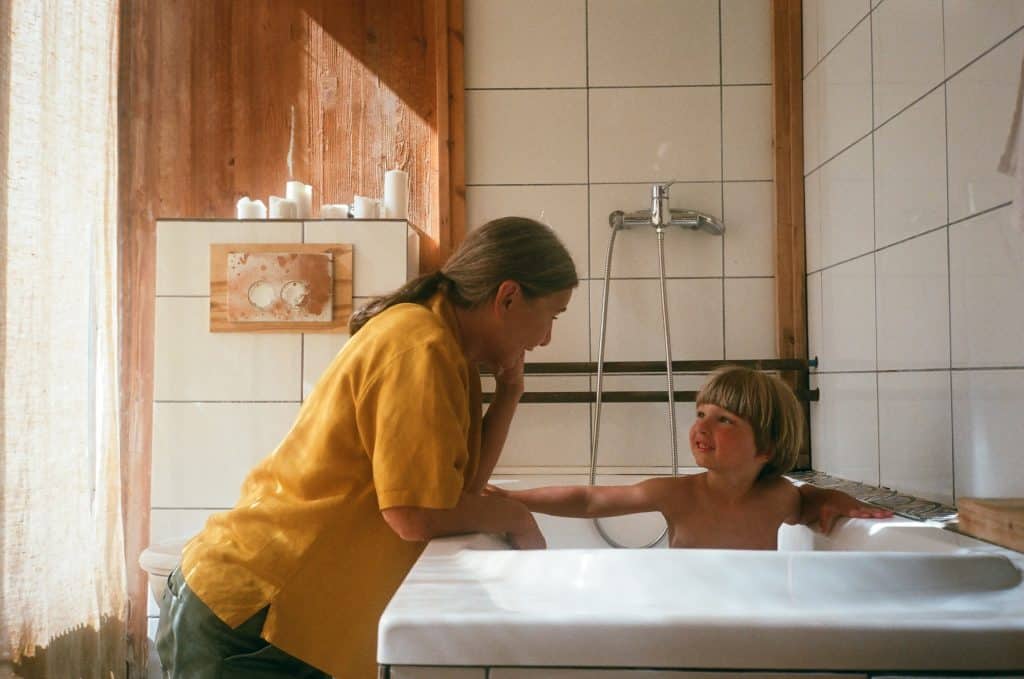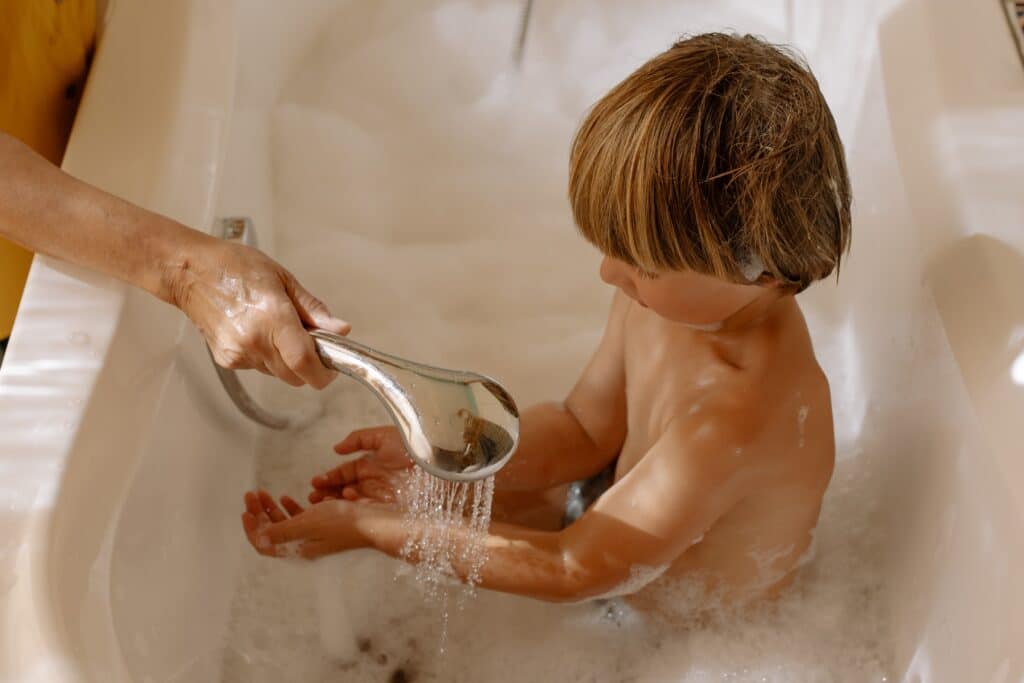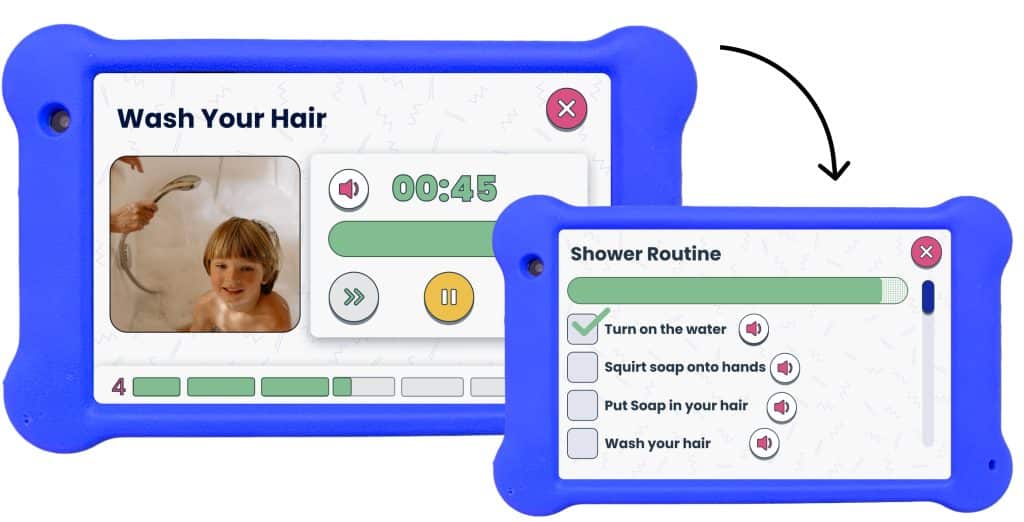Showering can be overwhelming for kids with autism due to sensory sensitivities, confusion, or distress around hygiene routines. Understanding these challenges and using the right strategies can make bath time easier and less stressful for both children and caregivers.
Key Takeaways:
- Establishing a consistent routine and offering choices can make showering more manageable.
- Sensory sensitivities can make showering feel uncomfortable or even painful.
- Many kids with autism struggle with transitions and routines, making bath time challenging.
- Safety concerns, including fear of water or slipping, can add to the stress.
- Using visual schedules, sensory-friendly products, and gradual exposure can help.
Table of Contents
Autism and Bathtime
The first step is being fully aware of the challenges you are facing. Although bathing and showering is second nature to a lot of us, when we really think about it, there is a lot going on in that tub. Your child with autism is very likely fully aware of all of them. This means there are so many things to consider from the child’s point of view that could make them dread bath time.
Some things that may trigger heightened senses during bath time include:
- The sounds of water running and splashing
- Distress over the water being too hot, cold, high, or low
- Aversion to air temperatures after getting out
- Disorientation from being in a small confined space
- Difficulties maintaining bodily control on slick, glossy surfaces
- Instability from stepping in and out of the tub
- Panic over the plughole and all the abnormal sights and sounds that occur once its unplugged
- The feeling of water on their skin, hair, or face
- Water temperature and water level in the tub
- Interpretation of the sound as alarming or threatening
Making things even more frustrating is that sometimes kids have a great time in the bath or shower, only the next time to hate it with extreme prejudice. Maybe a child will even grow out of an initial dislike of bathing, only for it to return a few years later or when puberty hits and the need for showering increases tenfold.

Read More: How to Make Showering Easier for Autistic Kids and Teenagers
Be Aware of Any Communication Challenges
Enhancing the challenge even further is the inability to properly communicate. It can be especially tricky to calm, orientate, and guide your child through the process when they’re too worked up to listen or talk. And once you get stressed, the challenges snowball from there. (Pro tip: This is why many people who are nonverbal or have trouble communicating when they get stressed use an AAC talker app to help them.)
| Step | Description |
|---|---|
| 1. Identify the Autism Related Stressors of Showering | This step requires understanding your child’s unique triggers during bath time. Knowing what causes discomfort or stress can be an essential first step in streamlining the showering process. |
| 2. Autism and Showering: Help Your Child Feel Secure in the Bath | Implementing safety measures and making the bath a comfortable place should be your priority. You could use non-slip mats, or a favorite toy, to create a sense of security during bathing. |
| 3. Calm Your Child Before Bath Time | Preparation can significantly reduce bath time stress. Engage in calm, soothing activities prior and keep a steady routine to help set expectations. |
| 4. Make the Bathing Environment All About Your Child | Personalize the bath environment to suit your kid’s tastes. Incorporate their favored colors, bath toys, or play soothing music to make it more enjoyable. |
| 5. Autism and Showering: Make Bath Time Fun | Try to make bath time a fun activity instead of a chore. You could sing songs, play games, or introduce bath-friendly toys. But, above all, be patient- allow your child to go at their own pace. |
5 Tips to Make Bath Time More Enjoyable for Children with Autism
So, how can you add fun to bath time? It all comes down to the right tools and setting realistic expectations. Whether it’s a favorite rubber ducky or a calming lavender bubble bath, the right elements can work wonders. Preparing your child for what’s coming can ease their apprehension, making the process smoother. With the right approach, bath time can transform from a daunting task into a delightful experience for you both!
1. Identify the Autism Related Stressors of Showering
If you already know what upsets your child about bath time, that’s great! Knowing is definitely half the battle here. But if you’re not sure exactly what’s causing the distress, using trial and error may be your best approach. Before you do though, here are some common questions (and solutions) to verify what’s really going on.
- Does the bathing process take too long? Keep track of how long bathing is taking from one session to the next. Once you find that sweet spot, set a countdown timer to help the child know the end of bath time is coming soon.
- What is the ideal water temperature for autism & showering? Keep a thermometer nearby to test water temperature at every stage of bathing, during meltdowns, and when things are calm. One study found that hot baths made autistic children more sociable and reduced repetitive behavior when lasting 30 minutes and with the water temperature at exactly 102 °F. A couple of degrees below and the results were completely different. Most of the time, managing your autistic child’s behavior is not an exact science. But sometimes it can be.
- What is the ideal water level for autism & showering? Keep a ruler nearby to test water height. Once you find that ideal temperature and height you can prepare a bath with the best chance of success.
- Is it too cold to get out of the tub when your child is soaking wet? Make sure warm towels are ready for wrapping up in at the end of the bath. Electric towel warmers can work wonders, or put a towel in the dryer right before use.
Listen to Your Kid’s Needs
- Does your child with autism hate the feeling of being wet when showering? Be sure you’ve laid a change of clothes out ahead of time so post-bath time doesn’t prolong the trauma.
- Who is in control of washing during your child with autism’s showering? Sometimes, allowing your child to take a bit of control is enough to stop distress from building into a full-blown meltdown. So if you’re personally doing all the scrubbing, lathering, rinsing, and washing, see if your child responds differently if they handle the tasks themselves.
- Do they respond differently to a bath versus a shower? An autism shower routine may work better for your child than a bath. For some children, a bath will work better. Don’t be afraid to try different things until you find a combination that works best for you and your child. Experimenting is key.
- What is their preferred towel and washing texture? For many children with autism, there are definite texture preferences. A washrag doesn’t have the same texture as a loofah or a sponge. The texture of towels can vary from one to another, and their texture can become an even bigger issue, depending on whether you gently towel dry your child or use a more vigorous rub.

Read More: 4 Tips for Getting a Haircut with Autism
2. Autism and Showering: Help Your Child Feel Secure in the Bath
The first step in making your child feel secure is feeling secure yourself. Finding the right bath or shower routine can be a process. It involves trial and error, patience, and going slowly to find what works best for you and your child. So make sure you’re in the right state of mind going in. One way to make this easier is striving to etch out ample time for bathing. One of the quickest ways to get stressed is to feel rushed in what you’re doing. The next step is finding ways to make them feel in control, secure, and protected.
Here are a few examples:
- Issue: Your child negatively reacts to getting water or shampoo in their eyes
- Response: Offer swim goggles or a foam or plastic visor to keep water and shampoo out
- Issue: Your child can’t stand rinsing off
- Response: Try letting them rinse themselves off using a hand-held shower hose
- Issue: Your child does not like water on their skin.
- Response: Try using much less water in the tub, maybe only two inches to start.
- Issue: Your child has trouble with balance standing, getting in, and getting out of the tub
- Response: Attach a bath grab bar, traction mat, or safety railing to help with stability
Over time you will learn your child’s bathing preferences and improve the process. With enough attention, patience, and perseverance you’ll be happy with the results. Of course, we realize that’s easier said than done. But don’t give up! The most important thing you can do throughout this process is to communicate with your child.
Read More: Interoception and Autism | Guide for Parents
3. Calm Your Child Before Bath Time
The calmer your child is going into bath time, the better chance of them remaining calm throughout. If you find your child is overstimulated by bathing, consider having them do a little “heavy work” before the bath to help calm them down. This can mean going up and down the stairs or jumping on a mini-trampoline. Hugging your child, carrying boxes, walking pets, and yoga stretches are all good examples of proprioceptive input, commonly called “heavy work.” Another way to offset the overstimulation of bath time is by moving it to earlier in the afternoon or evening, rather than bathing just before bedtime.
4. Make the Bathing Environment All About Your Child
Those first three steps are more about getting your child with autism in the right mood — a neutral, accepting state. Once there, the window of opportunity is open to make the experience not just enjoyable, but something to look forward to. Here are some tips to make the bathroom more comfortable for your kid:
- If noises are bothersome to your child with autism… Make sure there are plenty of towels, robes, rugs, and other fabrics in the room. If necessary, spread extra towels or rugs on the floor. Bathrooms can act like echo chambers, and fabrics help absorb the sounds that may bounce off multiple hard surfaces. You may also find it easier to prepare the bath ahead of time. Close the door while filling the tub, then turn the water off. Wait until the room is calm and quiet before bringing your child in to bathe.
- If bright lights are troublesome to your child with autism… Consider installing a dimmer switch, or turning off the bathroom light and only use a lamp or hallway light for illumination.
- If certain smells overstimulate your child with autism… It goes without saying bathrooms are one of the smelliest places in our homes. Try to make the room odor-free. Or use air fresheners. You may find using essential oils in an aromatherapy diffuser helps create a more soothing, relaxing autism bath time experience as well. Include your child in the process by allowing them to choose their favorite scents. Imagine creating a kid-friendly spa for your child. Sounds ridiculous right? Not when you’re in the throes of a tub tantrum. Wooosaahhhhhh!
5. Autism and Showering: Make Bath Time Fun
Last but certainly not least, if you want your child to enjoy taking baths make them fun! You know what this means… Toys! Toys! And more TOYS! There is no shortage of waterproof dolls and action figures, wind-up toys designed for moving through sudsy water, special bath time crayons, or even just plain plastic cups and containers.
But even if you don’t want to turn your bathroom into a tiled toy box, there are plenty of other ways to make bath time less of a bore and more of a game. In fact, take that literally and turn your bath time into a game. Here are some great splish-splashing fun bathtub games and activities from Parents.com to get you started.
Here are some strategies that may help:
- Use a shower chair or stool for added support and comfort
- Set the water temperature to a comfortable level, avoiding extremes of hot or cold
- Adjust the water pressure to a gentle flow
- Help your child feel comfortable in the bathroom and the shower
- Consider swapping in softer lights
- Establish a consistent routine for showering
- Provide sensory support by using soap
Other things to consider include:
- They might not understand the importance of personal hygiene or the social implications
- They might need reminding to have a shower
How Goally Helps Reduce Autism and Showering Stress
With the ability to set up routines and rewards in the Goally, it’s easy to include a bath or shower routine. Goally’s visual schedule app uses visual and audio cues to guide your child throughout their daily activities.

With Goally, fostering independence in your child through step-by-step bath time instructions becomes a breeze. By setting custom prompts in Goally, you offer your child with autism more autonomy over their shower routine. Goally transforms the way you teach new skills to your child, and builds a foundation for bigger goals.
Goally breaks down complex tasks into manageable steps that your child can easily follow. As kids with autism often excel in visual learning, each step features a visual timer, vibrant images or videos, and plenty of color to keep them engaged. Plus, you can monitor how long they take in the shower every day and track how often they complete the routine successfully, ensuring progress and growth in their independence.
Special Sensory Issues to Consider during Bath Time
If your child also has a diagnosis of SPD, this could intensify bathing challenges. Did you know that there are 8 sensory systems? Visual, tactile, interoception, olfactory, gustatory, vestibular, proprioception, auditory… yeah, okay you get it. There are a LOT of ways to sense things.
Now, imagine all of the following sensory inputs hitting you at the same time, triggering all 8 systems:
- Bright bathroom lights
- Mirrors reflecting illumination
- Rough textures of the washrag and towel against sensitive skin
- The feel of water on the skin, hair, or face
- The slippery slickness of the tub’s surface
- The smell of soap
- The slimy feel of the shampoo
- Bathtime towels and robes
That’s a LOT of sensory input to the process! Especially when it occurs in a very short period of time. It is little wonder that the combination of autism and showering can turn into a terrifying situation. Being aware of this and helping them take in one thing at a time can quickly help calm down your child with SPD or autism as they get ready to shower.
Goally | 100+ Streaming Video Classes
Does your child need some extra guidance on building essential life skills? Goally’s skill building tablet for kids includes a TV app that has the most robust video library of skills training videos for kids. Ranging from content like “How to Brush Your Teeth” to “How to Make Friends at School,” we have dozens of interactive video lessons for kids with thinking and learning differences.

HERE’s a video explaining how to works.
Just remember, if your child is screaming during bath time, they’re not just having a fit … they’re in distress. Often, it’s due to sensory overload or specific fears. As they grow, proper hygiene becomes more important. By making bath time a pleasant routine from an early age, you’re helping them develop good hygiene habits for life. With some planning, bath time need not be dreaded by either of you. The key is to remain patient and optimistic!
Resources:
FAQs about Autism and Showering
Why do children with autism struggle with showering?
Many children with autism have sensory sensitivities that make the feeling of water, temperature changes, or soap overwhelming.
How can I make showering easier for my child with autism?
Use visual schedules, sensory-friendly products, and a consistent routine to reduce stress and increase comfort.
What are common sensory issues related to showering for kids with autism?
Loud water sounds, temperature changes, and the sensation of soap or water on the skin can be distressing.
How do I help my child with autism overcome fear of the shower?
Gradual exposure, letting them control the water flow, and using familiar bath toys can make it less intimidating.
Are baths or showers better for kids with autism?
It depends on the child’s sensory preferences—some may prefer the deep pressure of a bath, while others tolerate a quick shower better.
This post was originally published on 11/22/2021. It was updated 03/12/2025.

Hennah is an experienced writer and researcher, helping children with autism, ADHD, and other neurodivergent conditions. As a blog contributor for Goally, she combines her deep understanding of neurodiversity with practical advice, offering valuable insights to parents and educators.





